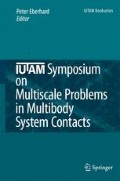Abstract
The discrete (or distinct) element method (DEM) has been recently recognized as efficient numerical tool for solving many scientific and technological problems in various fields of engineering. The method started in the 70-ies with its first application to simulate the dynamic behaviour of granular material in the work of Cundall and Strack [1]. Unlike the continuum approach, the DEM presents particulate material as an assemblage of discrete elements. It is based on the Lagrangian approach, according to which particles of granular material are treated as contacting bodies, while the dynamical parameters (i. e. position, velocity, orientation, etc.) of each body are tracked during the simulation. Some variations on the theme of DEM and granular materials may be found in [2]–[5].
Access this chapter
Tax calculation will be finalised at checkout
Purchases are for personal use only
Preview
Unable to display preview. Download preview PDF.
References
Cundall PA, Strack ODL (1979) A discrete numerical model for granular assemblies. Géotechnique 29(1):47–65
Džiugys A, Peters BJ (2001) An approach to simulate the motion of spherical and non-spherical fuel particles in combustion chambers. Granular Matter 3(4):231–266
Luding S (2002) From microscopic simulations to macroscopic material behavior. Computer Physics Communications 147:134–140
Zhang N, Rosato AD (2004) Analysis of instantaneous dynamic states of vibrated granular materials. Mechanics Research Communications 31(5):524–544
Balevičius R, Kačianauskas R, Mroz Z, Sielamovicz I (2006) Discrete Element Method applied to multiobjective optimization of discharge flow parameters in hoppers. Structural and Multidisciplinary Optimization 31(3): 163–175
Tomas J (2004) Fundamentals of powder consolidation and flow. Granular Matter 6(2–3):75–86
Asmar BN, Langston PA, Matchett AJ, Walters JK (2002) Validation tests on a distinct element model of vibrating cohesive particle systems. Computers and Chemical Engineering 26:785–802
Allen MP, Tildesley DJ (1991) Computer simulation of liquids. Clarendon Press, Oxford
Balevičius R, Kačianauskas R, Džiugys A, Maknickas A, Vislavičius K (2005) DEMMAT code for numerical simulation of multi-particle dynamics. Information Technology and Control 34(1):71–78
Balevičius R, Džiugys A, Kačianauskas R (2004) Discrete element method and its application to the analysis of penetration into granular media. J. Civil Engineering and Management 10(1):3–14
Nedderman RM (1992) Statics and kinematics of granular materials. Cambridge University Press, New York
Clearly PW, Sawley ML (2002) DEM modelling of industrial granular flows: 3D case studies and the effect of particle shape on hopper discharge. Applied Mathematical Modelling 26:89–111
Zhu HP, Yu AB (2005) Steady-state granular flow in 3D cylindrical hopper with flat bottom: macroscopic analysis. Granular Matter 7:97–107
Emeriault F, Claquin C (2004) Statistical homogenization for assemblies of elliptical grains: effect of the aspect ratio and particle orientation. International Journal of Solids and Structures 41:5837–5849
Mirghasemi A, Rothenburg L, Matyas E (2002) Influence of particle shape on engineering properties of assemblies of two-dimensional polygon-shaped particles. Géotechnique 52(3):209–217
Author information
Authors and Affiliations
Editor information
Editors and Affiliations
Rights and permissions
Copyright information
© 2007 Springer
About this paper
Cite this paper
Kačianauskas, R., Balevičius, R., Markauskas, D., Maknickas, A. (2007). Discrete Element Method in Simulation of Granular Materials. In: Eberhard, P. (eds) IUTAM Symposium on Multiscale Problems in Multibody System Contacts. IUTAM Bookseries, vol 1. Springer, Dordrecht. https://doi.org/10.1007/978-1-4020-5981-0_7
Download citation
DOI: https://doi.org/10.1007/978-1-4020-5981-0_7
Publisher Name: Springer, Dordrecht
Print ISBN: 978-1-4020-5980-3
Online ISBN: 978-1-4020-5981-0
eBook Packages: EngineeringEngineering (R0)

